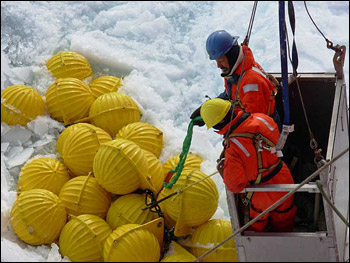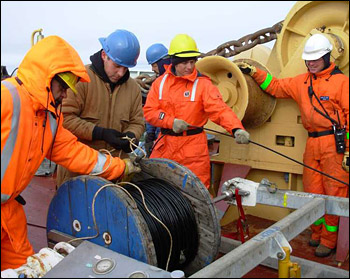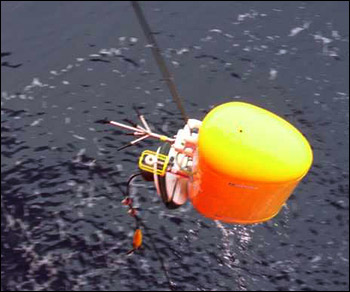Please note: You are viewing
the unstyled version of this website. Either your browser does not support CSS
(cascading style sheets) or it has been disabled. Skip
navigation.
Rick KrishfieldAugust 17, 2006
When we arrived on the mooring site in the morning, we were easily able to wake up the first release instrument which attaches to the anchor at the bottom of the subsurface mooring. By sending acoustic signals down from the ship using a specially designed deck unit and transducer, commands can be given to the release to wake it up, ping, and release the mooring. By pinging on it, and determining the amount of time it takes for the ping response, we can get a range to the release instrument. By doing the same thing from different locations, we can determine the exact position of the mooring by the intersection of the triangulating circles (for more detailed information refer to WHOI Technical Report 2005-5). Since the release pinged reliably, we thought that it would release reliably - it did not. After the Captain (Andrew McNeill) cleared a spot free of ice for the surface float to pop up, he gave us the okay to release. However, after numerous attempts, the first release did not fire. Consequently, we enabled the backup release and gave that unit the release command. It worked, but only after we had drifted far enough away that the open water area was no longer directly over the top float. So the top float came up under the ice. Now, by pinging the same way as we did for the survey, we had to follow the releases which hang below the backup floats to locate those floats. Forty-five minutes later, they were at the surface, but also under ice. By homing in on them, they were located under a small ice floe. Eventually the Captain was able to persuade the floats out from under floe using the weight of the Louis, and Will Ostrom and Bill May were lowered in a basket to attach a line to cluster of floats. So we proceeded to recover the mooring from the bottom first, retrieving the floats, bottom pressure recorder and releases, then hauling in about 2 miles of wire rope before the top float finally pulled out from under the ice and surfaced. When the top float became accessible, the mooring wire was terminated and cut, and the ship maneuvered to the sphere, so that we could recover the rest of the system from the top. The last item to be recovered was the MMP profiling CTD instrument, nearly 12 hours after arriving on site and beginning the day. Last updated: October 7, 2019 | |||||||||||||||||||
Copyright ©2007 Woods Hole Oceanographic Institution, All Rights Reserved, Privacy Policy. | |||||||||||||||||||





